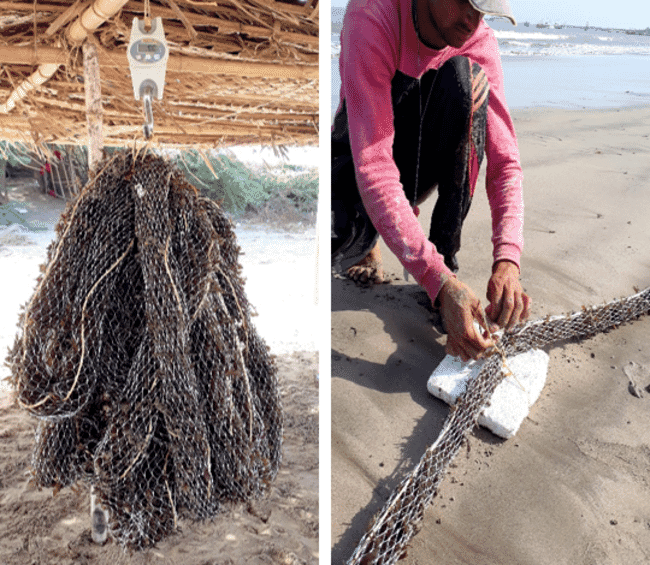So conclude the authors of a new study into the economic benefits of farming Gracilaria seaweed along the coast of Gujarat.

© Mantri et al, 2020
Currently more than 114,1000 tonnes of dry Gracilaria (a genus of red algal agarophyte) are produced annually around the world – largely for use in industrial agar production. However, a high proportion of these are harvested from the wild and there is a pressing need to supplement dwindling wild stocks with farmed ones.
The new study, undertaken by researchers from India’s Council of Scientific and Industrial Research (CSIR), involved the first experimental trial of farming Gracilaria dura in tube-nets along the west coast of India and aimed to provide the basis for scaling-up the activity for industrial adoption. Emphasis was given to the business model, in order to assess the commercial potential of farming the seaweed and reducing India’s dependency on imported agarose.
Tube nets were chosen, the researchers explain, “as the Gujarat coast experiences moderate to strong water currents and thus monoline and raft methods which are routinely used elsewhere are not suitable for undertaking cultivation there.”
The trial took place for seven months (from October to May) and result showed that the mean daily growth rate (DGR) of this agarophyte was found to range from 1.88 ± 0.23% day−1 to 3.30 ± 0.25% day−1. Similarly, the mean yield varied between 0.62 ± 0.03 kg and 1.05 ± 0.02 kg fresh wt m−1 of tube-net.

© Mantri et al, 2020
A Pearson correlation showed that both DGR and biomass yield were positively correlated with temperature. In addition, the DGR was significantly positively correlated with air temperature (r = 0.916; p < 0.01) whereas biomass yield was also positively correlated with surface seawater temperature (r = 0.986; p < 0.001).
The economic projections, based on four harvests per year, suggest that seaweed valued at US $5,577 could be produced each year, and the estimated profit was $3,780, which corresponded to $354.37 per person per month. They noted that this figure was substantially higher than that for Gelidiella acerosa ($200), Gracilaria edulis ($125.41), G. dura ($240.83) and G. debilis ($141) cultivated by the raft method along the southeast coast of India. And they added that this equates to “a significant amount in the coastal communities of Gujarat”.
As a result, the researchers concluded that: “The results obtained in these pre-feasibility trials confirmed sustainable income to the farmers, and thus undertaking commercial farming would diversify the livelihood of coastal fishermen and give impetus to the indigenous production of agarose.
Further information
The full study, which was published in Applied Phycology under the title "Feasibility of farming the agarose-yielding red alga Gracilaria dura using tube-net cultivation in the open sea along the Gujarat coast of NW India", can be accessed here.


